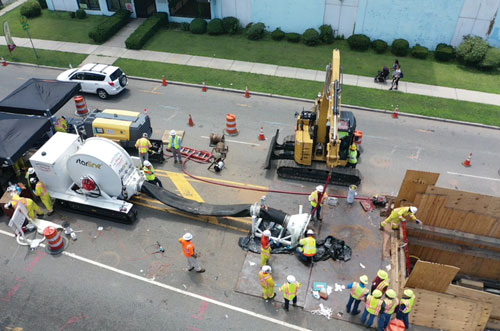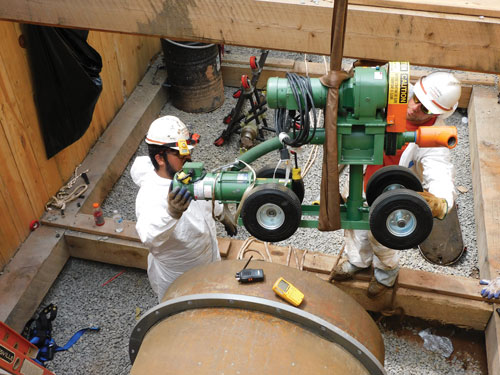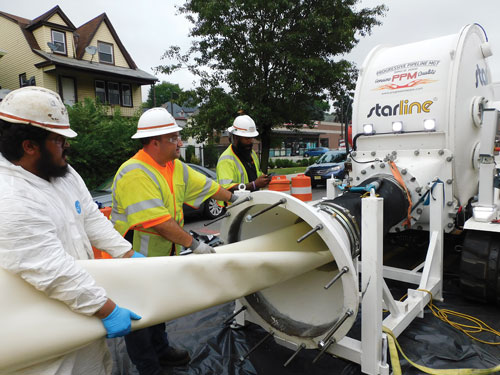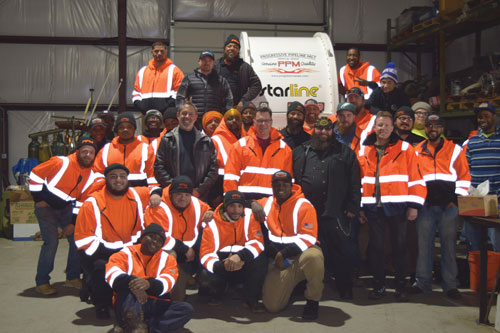February 2020 Vol. 75 No. 2
Rehab Technology
New Record for Gas Main Relining
Jeff Griffin | Senior Editor
With rehabilitation of a 620-foot-long segment of 42-inch-diameter gas main last summer, New Jersey contractor Progressive Pipeline Management (PPM) broke its own world record for the largest size natural gas pipe to be rehabilitated with Starline cured-in-place pipe (CIPP) liner.
Location of the project was East Orange, N.J., in a highly congested area with multiple freeways, underpasses and a hospital. The project owner was Public Service Electric & Gas (PSE&G).
CIPP lining has become common for sanitary sewer rehabilitation, but the lining materials used for this work is unable to withstand the high pressures of natural gas lines. The Starline liner used on the record-setting project was developed specifically for lining high-pressure pipes, said David Wickersham, CEO of Progressive Pipeline Management.
The rehabilitated cast iron gas line running along Central Avenue in East Orange had multiple grade changes, seven offsets and material changes from cast iron to steel. It travels 80 feet directly down an embankment and then crosses under the Garden State Parkway and back up the other side to street level. Central Avenue is 25 feet higher than the parkway.
“In the dense area of the East Orange project location,” said Wickersham, “there was no viable alternative to trenchless rehabilitation for renewing this gas main. In many of the urban, historic, paved and high-traffic areas where PPM is called in to solve a problem, the cost and disruption would be astronomical to dig up the old pipe and lay new pipe. To replace this section of pipe conventionally would have cost of millions of dollars and created massive disruption.”
Using a trenchless method was significantly less costly than open cut construction would have been, even if possible, Wickersham said. The street remained open during the project.
Live, closed-circuit-television inspection, months before the project’s start, confirmed the internal conditions of the pipeline, including geometry, anomalies and fittings. All tests were performed under live conditions without interruption of service to customers.
Cleaning
Before the lining process started, cleaning of the pipe was essential. The large diameter of the pipe and its multiple bends presented challenges in the time required to clean, cleaning effectiveness and grit recovery.
Wickersham said the current cleaning method for smaller-diameter pipes is to pull a sandblasting cleaning head through the pipe, prior to engaging the grit blast. Once the head is confirmed at the start location within the pipe, the grit blast is initiated, and the head is pulled back at a slow rate. While effective, it takes time to pull the head in with a winch.
“PPM,” he explained, “identified a self-propelled robotic sandblasting head with an electric motor for internal cleaning of pipelines in diameters of 36 inches and larger. No staging is required. Using it, the head went in and the crew was cleaning within 10 minutes. It worked brilliantly. Its video camera allowed real-time views of results as cleaning progressed. The crew affectionately named the device ‘The Beast.’”
To remove all dust and particles from the pipe, extensive testing and reconfiguration of the vacuum equipment was performed to optimize velocities impacting flow rates and minimize expected extraction difficulties, due to the unusual “U” configuration of the pipeline that went down and back up a steep embankment.
“We deployed two dust collection units with a total 64,000 CFM air flow that proved to be the ‘silver bullet’ allowing complete grit recovery,” Wickersham said. “This was a milestone considering the pipe diameter and geometry.”
Based on lessons learned from the previous world record of lining 36-inch pipe, a special inversion drum was designed and fabricated that increased capacity. The use of a transport hose significantly reduced above-ground equipment footprint during curing. These modifications reduced equipment set-up time and increased crew efficiency.
The 620-foot-long liner was inverted through a total of seven bends (two of which were mitered steel bends within a short section of steel) and a drip pot with a 48-inch gap that was bridged with an internally installed, forged steel structural reinforcement sleeve.
Fast work
Lining was completed in only three days, and the overall project was finished two-and-a-half weeks ahead of schedule.
The Starline liner was developed by Karl Weiss, a German company with extensive experience in natural gas renewal applications and subsurface engineering. The patented technology utilizes a liner that is bonded to the host pipe with a special epoxy. The two-part epoxy is mixed onsite and applied to the liner immediately prior to the installation. The liner/epoxy then cure at ambient temperatures, typically within 24 hours during warmer months.
Advantages of the lining include that it does not significantly reduce pipe capacity, and rehabilitation of pipe requires minimal excavation and restoration. Also, gas cannot because the liner uniformly bonds to the pipe.
According to Wickersham, Starline liner has undergone $15 million of extensive testing over 15 years with the Pipeline Hazardous Materials and Safety Administration, Cornell University and NYSEARCH, a member-driven, collaborative research and development organization serving gas utilities, to ensure that it is safe, reliable and effective. Independent testing of Starline CIPL in live pressurized gas service determined the product has a 100-plus year life.
PSE&G is one of the largest combined electric and gas companies in the United States and is also New Jersey's oldest and largest publicly owned utility. The PSE&G engineer for the project was George Ragula, distribution technology manager.
Based in Wenonah, N.J., Progressive Pipeline Management is a full-service contractor and a highly skilled infrastructure renewal specialist. PPM’s primary expertise is trenchless technologies to restore aging, damaged or leaking underground infrastructure, including pipelines of all types and sizes. The contractor is the North American licensee in the U.S. for Starline technology. •
FOR MORE INFORMATION:
Progressive Pipeline Management, (855) 246-6344, progressivepipe.com
Karl Weiss, +49 30 31 17 62-0, karl-weiss.com/starline-technology.html








Comments